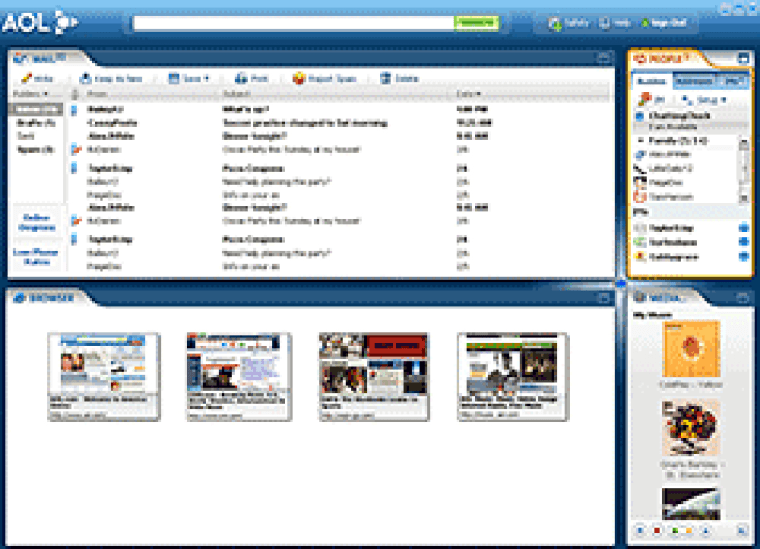AOL is getting a software makeover, its first since deciding to make more of its services available for free in the chase for online advertising dollars.
With Wednesday's launch of OpenRide — the name reflecting AOL's shift away from its traditional closed-door approach of charging for services and features — the company is hoping to keep broadband multitaskers glued to its key free offerings through an all-in-one program.
Unlike traditional Web browsers in which users perform one task at a time, OpenRide splits the main window into four panes — for e-mail, instant messaging, video and general Web browsing. It also has a prominent search box up top — tied to AOL's search engine.
The panes automatically resize depending on what a user is doing at the moment, while giving users a glance of all the main tasks.
For example, when checking video or other media, a pane with a built-in media player takes up most of the space, but users still get smaller panes above and to the side showing new mail, instant messaging chats and small, thumbnail versions of Web pages they have open.
And unlike previous versions of AOL's all-in-one software, users won't have to sign in until they need to access a specific service like e-mail.
"You can get right to the content," said Joel Davidson, AOL's executive vice president for access products and technology. "You don't have to go through any wall."
The software can be downloaded at http://www.aol.com/openride for free.
Davidson said AOL is counting on drawing former AOL subscribers who have gone to rival services from Yahoo Inc., Google Inc. and Microsoft Corp. because they didn't want to pay monthly fees of as much as $26. He acknowledged OpenRide might not appeal to "high-end geeky Web users" accustomed to mixing and matching software.
David Card, a Jupiter Research senior analyst, said AOL may have a tough time explaining to most people why they would need an integrated experience.
"It demos well, but I'm not sure what the demand for that kind of thing would be," he said. "It will be interesting to see how they will market it."
Over the past two years, AOL has been making its news articles, music videos and other services available for free in an effort to drive traffic to ad-supported Web sites to offset declines in subscription revenues. The Time Warner Inc. unit accelerated that shift in August when it also gave away AOL.com e-mail accounts and software once reserved for paying customers.
The devotion of panes to instant messaging and video in the new software reflects those services' importance in AOL's new strategy. And the prominence of an AOL search box underscores the company's desire to have people search there rather than at Google.com, even though Google provides the basic search technology for AOL and owns 5 percent of AOL LLC.
Davidson said AOL wants to ultimately integrate OpenRide with rival services as well, but for now, that is limited to e-mail accounts using the POP3 protocol. Among the major Web-based services, only Google's Gmail offers that for free.
Maribel Lopez, industry analyst with Forrester Research, said AOL still could draw traffic to emerging features like video even as it concedes that loyal users of rival e-mail services are unlikely to switch.
"A recognition the world is not an all-AOL universe is a healthy recognition," she said.
OpenRide requires Microsoft's Windows XP operating system with Service Pack 2, although AOL is planning a version for the upcoming Windows Vista. It will also offer a Vista version of OpenRide's predecessor, AOL 9.0.
The new software shares little of its predecessor's code. It takes advantage of Internet Explorer and Windows Media Player technology built into Windows, and an optional desktop search component helps users find files based on their contents rather than filename alone. The software also helps users keep track of their anti-virus and other security settings.
Roy Ben-Yoseph, director of AOL access product management, said OpenRide addresses complaints raised by researchers over bundling media players and other components without adequate disclosure. He said notice is improved, and most of those components already come with Windows, so OpenRide does not need to install them separately.
